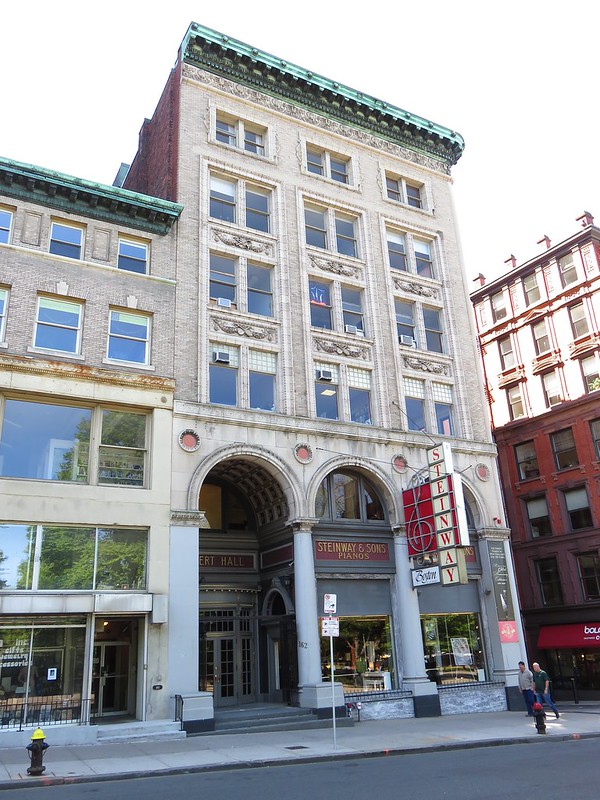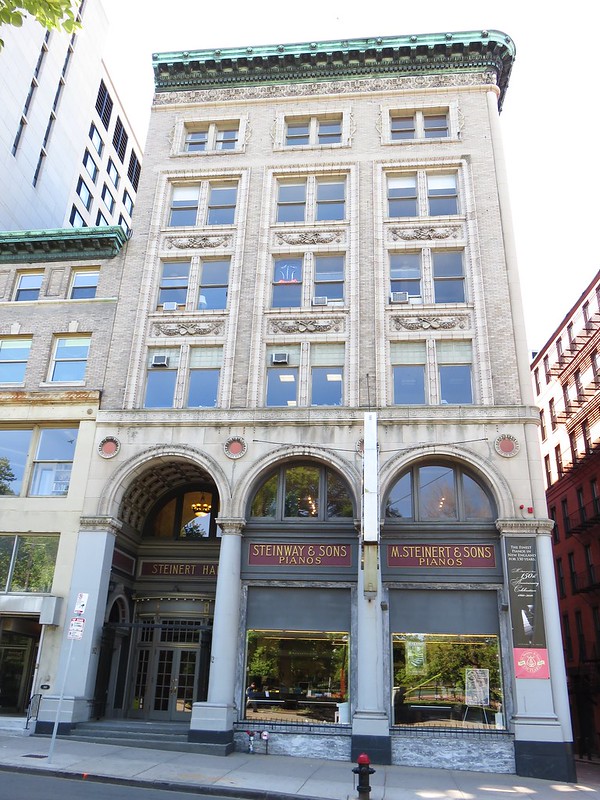My favorite "new" development. THIS is the type of thing that makes a city more interesting than just a big office park:
http://www.bostonglobe.com/metro/20...t-for-years/8MQY5GGMdKgxu8XMa58fBP/story.html
Steinert Hall
By Steve Annear Globe Staff May 22, 2015
Imagine it: the sounds of violins and cellos filling the room, swirling around the decorative molding of the long-shuttered theater. Or students from nearby colleges, strutting across the stage while belting out the chorus of a classic show tune.
That’s what the new owner of a building envisions for Steinert Hall — one of downtown Boston’s most intriguing secret places. The hall, a historic venue that’s 35 feet underground, has been silent for 72 years.
Developers from B Minor LLC recently purchased the six-story, 38,000-square-foot Steinert Building, at 162 Boylston St., across from the Boston Common.
Steinert Hall, which classical musicians have hailed as a marvel for its crisp and clean acoustics, is under the building. Long ignored, it has been used as storage for old piano parts, crates, and filing cabinets.
As developers begin planning renovations, a project that could take two to three years, they will draft a strategy to rehabilitate Steinert Hall, with the hope of reopening it to the public.
For decades before closing its doors to the public 70 years ago, the subterranean theater was a crown jewel in Boston’s performing-arts firmament.
“The intention is to really bring the whole building back to its former beauty, and incorporated in that would be to rehabilitate, reconstruct, and refurbish the concert hall,” said Jim Elcock, executive vice president and managing partner of Colliers International, the company advising the building’s new owner. (Boston Globe owner John Henry has hired Colliers to put the Globe’s Dorchester property on the market.)
William Mosakowski, chief executive of Public Consulting Group Inc., is lead manager of B Minor LLC. Mosakowski’s idea is to create a space that could serve as a concert hall or possibly a tourist attraction, Elcock said.
“They will take a look at how to best share it with the community, whether it’s a symposium, or a recital space, or a place for colleges and universities to have special events,” he said. “The intent is to fix it up — but not close the doors — and to share it and have it be a part of the Boston music, arts, and cultural scene.”
There’s no timeline for that plan.
The building’s former owner, piano dealer M. Steinert & Sons, has largely discouraged guests from visiting the old hall, citing safety concerns and code restrictions — hurdles the new owners must face head-on as they seek to reconstruct the venue. The hall has also been plagued by water damage over the years.
“While renovating this remarkable concert space and bringing it up to modern safety standards presents many intimidating challenges, B Minor LLC will investigate every avenue to try to revive Steinert Hall,” M. Steinert & Sons said in a recent blog post.
Paul Murphy Jr., owner of M. Steinert & Sons, said the company will move out of the building, which was built in 1896, while it is overhauled. The company plans to return when construction is complete.
“In order to upgrade and maintain the building, we have sold it to someone who has the depth and wherewithal to do something with it,” he said in a phone interview.
There’s a long road ahead for Steinert Hall, which includes a complex orchestration of drawings, bids, and permitting, said Elcock.
“I think there’s a 99 percent chance it’s going to happen. The owner was drawn to the building . . . . because of his love of architecture and space, and I think he looks at this as an opportunity to give something back to Boston,” Elcock said. “Given its acoustics and design, and [Mosakowski’s] love of the arts, he is going full-bore to refurbish this beautiful piece of space.”
Steve Annear can be reached at steve.annear@globe.com. Follow him on Twitter @steveannear.
http://www.bostonglobe.com/metro/20...t-for-years/8MQY5GGMdKgxu8XMa58fBP/story.html
Steinert Hall
By Steve Annear Globe Staff May 22, 2015
Imagine it: the sounds of violins and cellos filling the room, swirling around the decorative molding of the long-shuttered theater. Or students from nearby colleges, strutting across the stage while belting out the chorus of a classic show tune.
That’s what the new owner of a building envisions for Steinert Hall — one of downtown Boston’s most intriguing secret places. The hall, a historic venue that’s 35 feet underground, has been silent for 72 years.
Developers from B Minor LLC recently purchased the six-story, 38,000-square-foot Steinert Building, at 162 Boylston St., across from the Boston Common.
Steinert Hall, which classical musicians have hailed as a marvel for its crisp and clean acoustics, is under the building. Long ignored, it has been used as storage for old piano parts, crates, and filing cabinets.
As developers begin planning renovations, a project that could take two to three years, they will draft a strategy to rehabilitate Steinert Hall, with the hope of reopening it to the public.
For decades before closing its doors to the public 70 years ago, the subterranean theater was a crown jewel in Boston’s performing-arts firmament.
“The intention is to really bring the whole building back to its former beauty, and incorporated in that would be to rehabilitate, reconstruct, and refurbish the concert hall,” said Jim Elcock, executive vice president and managing partner of Colliers International, the company advising the building’s new owner. (Boston Globe owner John Henry has hired Colliers to put the Globe’s Dorchester property on the market.)
William Mosakowski, chief executive of Public Consulting Group Inc., is lead manager of B Minor LLC. Mosakowski’s idea is to create a space that could serve as a concert hall or possibly a tourist attraction, Elcock said.
“They will take a look at how to best share it with the community, whether it’s a symposium, or a recital space, or a place for colleges and universities to have special events,” he said. “The intent is to fix it up — but not close the doors — and to share it and have it be a part of the Boston music, arts, and cultural scene.”
There’s no timeline for that plan.
The building’s former owner, piano dealer M. Steinert & Sons, has largely discouraged guests from visiting the old hall, citing safety concerns and code restrictions — hurdles the new owners must face head-on as they seek to reconstruct the venue. The hall has also been plagued by water damage over the years.
“While renovating this remarkable concert space and bringing it up to modern safety standards presents many intimidating challenges, B Minor LLC will investigate every avenue to try to revive Steinert Hall,” M. Steinert & Sons said in a recent blog post.
Paul Murphy Jr., owner of M. Steinert & Sons, said the company will move out of the building, which was built in 1896, while it is overhauled. The company plans to return when construction is complete.
“In order to upgrade and maintain the building, we have sold it to someone who has the depth and wherewithal to do something with it,” he said in a phone interview.
There’s a long road ahead for Steinert Hall, which includes a complex orchestration of drawings, bids, and permitting, said Elcock.
“I think there’s a 99 percent chance it’s going to happen. The owner was drawn to the building . . . . because of his love of architecture and space, and I think he looks at this as an opportunity to give something back to Boston,” Elcock said. “Given its acoustics and design, and [Mosakowski’s] love of the arts, he is going full-bore to refurbish this beautiful piece of space.”
Steve Annear can be reached at steve.annear@globe.com. Follow him on Twitter @steveannear.
Last edited:





